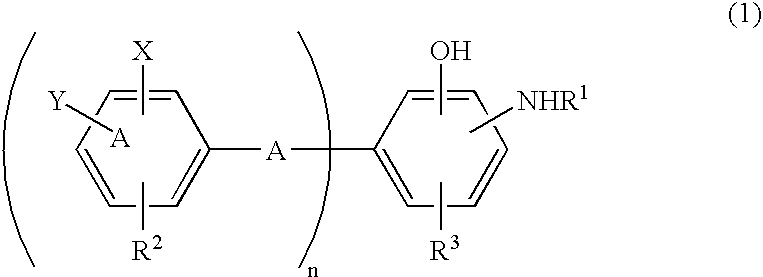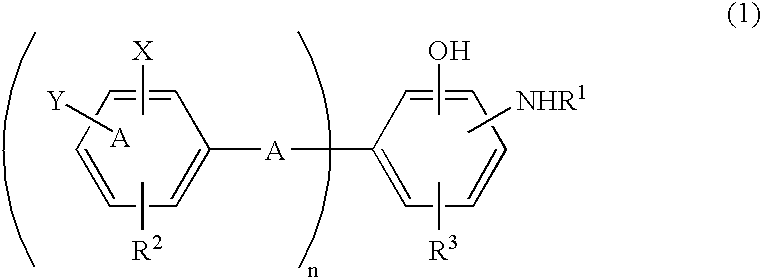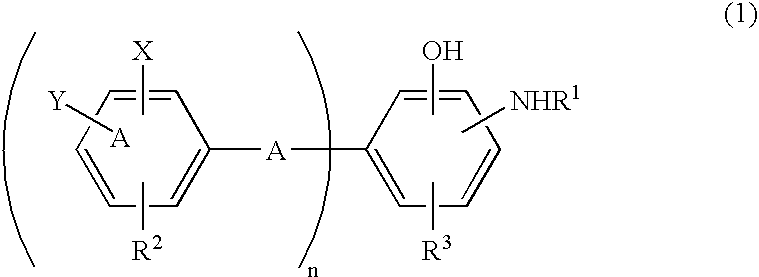Antioxidant and bisaminophenol derivative
a technology of bisaminophenol and bisaminophenol, which is applied in the field of antioxidants and aromatic hydroxyamine derivatives to achieve the effect of high oxidation-inhibiting properties
- Summary
- Abstract
- Description
- Claims
- Application Information
AI Technical Summary
Benefits of technology
Problems solved by technology
Method used
Image
Examples
example 1
Synthesis of 2-(isopropylamino)phenol
[0048]Into a 100 mL flask purged with nitrogen were added 12 g (109.92 mmol) of o-aminophenol and 60 mL of dimethylformamide (DMF), and the resultant mixture was stirred at room temperature and dissolved. Then, the obtained solution was mixed with 22.4 g (132 mmol) of 2-iodopropane such (molar ratio of 2-iodopropane to o-aminophenol: 1.2), and further with 11.4 g (114 mmol) of potassium hydrogencarbonate (KHCO3) as a catalyst, and the resultant mixture was stirred at room temperature for 5 h. After conducting the reaction for 5 h, 50 mL of water was added to the reaction solution to terminate the reaction.
[0049]As a result, it was confirmed that the rate of conversion of o-aminophenol was 72%, and the selectivity to the N-monoalkylated compound as produced (molar ratio of the monoalkylated compound to a sum of the mono- and di-alkylated compounds) was 73%.
[0050]The resultant reaction solution containing water was extracted with 50 mL of ethyl ace...
example 2
Synthesis of 2-(isopropylamino)phenol
[0051]The same procedure as in Example 1 was repeated except that the molar ratio of 2-iodopropane to o-aminophenol was changed to 1.0, the 2-iodopropane was dropped over 3 h, and then the reaction mixture was stirred at room temperature for 2 h.
[0052]As a result, it was confirmed that the rate of conversion of o-aminophenol was 58%, the selectivity to the N-monoalkylated compound was 99%, and the oxygen absorption initiation time as an index of determining an oxidation-inhibiting property thereof was 370 min.
example 3
Synthesis of 2-(isopropylamino)phenol
[0053]Into a 300 mL autoclave were charged 12 g (109.92 mmol) of o-aminophenol, 100 mL (79 g; 1.4 mol) of acetone, 0.6 g of Pd / C (Pd content: 5% by mass) and 30 g of MgSO4, and the contents of the autoclave were heated at 100° C. while stirring under a hydrogen pressure of 1.0 MPa. After the elapse of 1 h, the hydrogen absorption was ceased, and the reaction was terminated. The resultant reaction solution was subjected to suction filtration to remove Pd / C and MgSO4 therefrom, and the filtrate thus separated was concentrated and then mixed with water to crystallize a reaction product. The thus obtained reaction product was dried to obtain 2-(isopropylamino)phenol. As a result, it was confirmed that the yield of 2-(isopropylamino)phenol was 93%, and the oxygen absorption initiation time as an index of determining an oxidation-inhibiting property thereof was 370 min.
PUM
| Property | Measurement | Unit |
|---|---|---|
| temperature | aaaaa | aaaaa |
| pressure | aaaaa | aaaaa |
| pressure | aaaaa | aaaaa |
Abstract
Description
Claims
Application Information
 Login to View More
Login to View More - R&D
- Intellectual Property
- Life Sciences
- Materials
- Tech Scout
- Unparalleled Data Quality
- Higher Quality Content
- 60% Fewer Hallucinations
Browse by: Latest US Patents, China's latest patents, Technical Efficacy Thesaurus, Application Domain, Technology Topic, Popular Technical Reports.
© 2025 PatSnap. All rights reserved.Legal|Privacy policy|Modern Slavery Act Transparency Statement|Sitemap|About US| Contact US: help@patsnap.com



